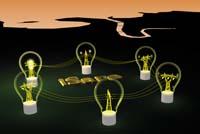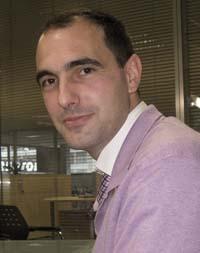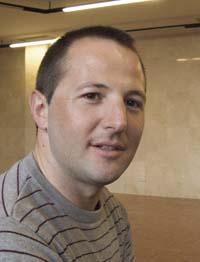iSare, embryo of the power grid of the future

According to experts, in the not too distant future, the grid will be smart, known as Smart Grid. It will drive electricity from where it is left to where it is needed and can be stored when it is not needed. Surely this network will not be perfect, but much less energy will be spent than today. The existing sources will be better exploited, leaving behind the current centralized energy state, dependent on fossil fuels and therefore polluting.
However, much work still needs to be done. You have to put many engineers working. We have to overcome very different problems. Many technologies must be fine-tuned and new ones created. It is a great effort, but engineers are already underway; researchers from around the world have begun to develop the concept of smart grid. Those who work in Gipuzkoa are included in the iSare project, in the construction of a microgrid that want to be installed in the Miramón Technological Park.
"We need to save energy, reduce costs, improve safety and reliability. How? Well, there have been some pilot experiences and those who know about this issue say that the solution is smart microgrids," explains Ibon Cerro, head of the R&D department at JEMA and coordinator of research in the iSare project. "With the existing energy demand, the grid is reaching its limits. In addition, demand is increasing, so microgrids must maintain this growth."
The idea is totally novel; energy will be created in the microgrids themselves and will be autonomous. However, they will also be connected to the general power grid in order to exploit the current power grid in the same way that it is exploited. Or so, the idea of Smart Grid is to create a network of smart microgrids. Experts seek a large intelligent structure of small intelligent components.
Gipuzkoa's iSare project responds to this approach. It's just a first step, one of those smart microgrids that engineers can experience. Over the years, once the iSare operation is fine-tuned, more micronetworks will be created and connected to each other. In this way, the future network will gradually increase.
With the iSare project and others that are working in the world, engineers want to create a revolution.

The journey of electricity
"The current network model is totally centralized," explains Haritz Macicior, CIDETEC-IK4 engineer. "Energy is generated in a few large cores, from where it is often distributed to very distant places."
To use the current network it is necessary to calculate previously the amount of energy needed at each moment. Keep in mind if night, day, noon, sunset, Monday or Sunday, and calculate previously the energy that will be consumed at every moment. To the calculation must be added the loss of energy in transport. "With the current network, the distance to go through energy is very large. [Along the way] can mean a 14% loss," says Macicio. Once the energy to be lost is added, more energy must be generated than the result of the calculation indicates. Just in case.
But they want to change that. Network intelligence means it will work differently. "We will not calculate the amount of energy we will need, but we will generate as much energy as we can until the capacity of energy storage systems is covered. And then the network will work to improve energy efficiency," says Cerro.
Technological challenges

There is intelligence. The network will read the sensors and can estimate where energy is needed at any time and where it can be extracted. In general, when energy is generated in the microgrids themselves, it must travel a very short distance from one area to another, since it will not be necessary to resort to a source located outside of it. This will minimize transport losses.
In this new structure the guards will have great importance. A microgrid cannot be managed if there is no accumulation of energy. Energy must be available at any time. The question is where. This is one of the main challenges for engineers, who need a solution for the future.
Three ways to store large amounts of electricity have already been proposed. The first is the most visible for street people: batteries. Just as energy is stored for the mobile phone in lithium-ion batteries, there could be electricity input batteries to the micro network. The problem is the size, with batteries much larger than those of the phone. Fortunately, this research advances very quickly.
"This moment is pretty good, as the automotive is driving the development of lithium-ion batteries," says Macicio. In addition, smart microgrids have an advantage over electric cars. "For iSare, for example, the evolution of the battery is not so important, as the batteries will be stopped. They should not move from one place to another continuously, in the case of the electric car yes, so they need very high energy density batteries to increase autonomy and reduce as much as possible the weight of the battery."
In any case, the idea of intelligent network is to incorporate batteries of vehicles into the network. It is possible that while the car is connected to the grid, the grid will remove electricity from the car instead of doing so, depending on demand. "It is not clear how it will be carried out, but experts say that in the future there will be millions of connected electric cars that will form a large warehouse from the point of view of the network," says Macizo. Low electricity consumption of the batteries of each car, there will be very high energy movements. And, for example, you can optimize the system to redirect electricity in small hours of the night and recharge cars before dawn.

The batteries will not be alone in this work. The second way to store energy is the supercapacitors. Capacitors are typical components of electrical circuits, which temporarily store electricity to instantly provide a high intensity short current. Engineers want to use the same idea, but on a large scale. To give an idea, in both cases one can compare the capacity of accumulation of electricity by a magnitude called capacity. The capacity of a conventional capacitor is measured in microfades, while that of a supercapacitor is measured in faradetan -millions of times more capacity. "We're talking about supercapacitors with 63 bales, for example," says Cerro.
The third proposal is the flywheels of inertia; instead of being stored in electrical form, energy accumulates accelerating the circular motion of a steering wheel; then it can be recovered by reverse conversion, that is, generating electricity with that movement.
These are three different ideas that will not be supported in any of them. "All three will be tested in Miramón," says Cerro. "We believe all three are suitable for micronetworks." One of the objectives of iSare is to prove this suitability in reality.
An opportunity for renewables
The combination of large energy storage systems and an intelligent management network is good news, especially in the field of renewable energy sources. "Now there are times when wind turbines stop because there is nowhere to store the energy they generate. Depending on the wind, they have to turn them off from time to time," says Cerro. "But we want all possible energy to be generated, the network will save and manage it later. We want to generate energy when there is wind or while the sun sounds."

Photovoltaic plates and two wind turbines, one vertical axis and one horizontal axis, will be installed in Miramón. "We still have to do studies to know where the wind sounds." However, it will be installed. They are essential for the microgrid.
The entire network will require great coordination work, but Ibon Cerro is very optimistic. "All research can be done in Gipuzkoa. We believe that with this project Gipuzkoa will be a reference. In Europe and the United States, experts talk about these networks and there are similar projects. Of course, we're not the first, but we hope to be among the top five."
Many other researchers are developing specific projects related to the smart grid, but very few are preparing a complete microgrid. "There are fewer than ten in Europe right now," says Cerro. In Gipuzkoa will be iSare, if everything goes well, by the end of 2012. Therefore, intelligence is close to the power grid.





